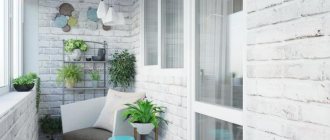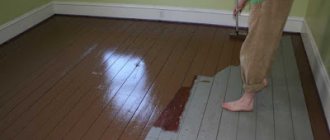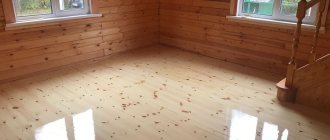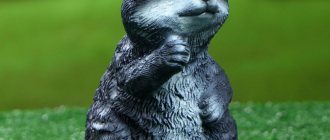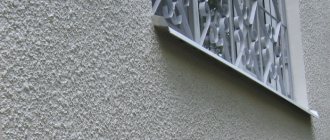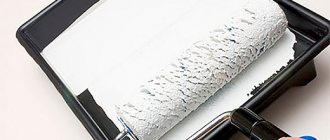Please help me understand what is the semantic difference in the phrases “break from work” and “break from work”? I would be very grateful for a detailed answer with more complete rules for using this word.
Example: "Painting a single area can be a welcome break from the persistent painting of walls."
Russian help desk response
That's right: a break from persistent painting of walls. True, we must say that in this case it is better to replace the word stubborn or reformulate the entire sentence.
Hello. Tell me, please, is it possible to put an equal sign between the words “ambition” and “desire”? Are they equivalent? And what is their stylistic coloring? Thank you.
Russian help desk response
These words are not equivalent. You can find their interpretations in electronic dictionaries on our portal.
which is correct: indigo dyeing or indigo dyeing
Russian help desk response
Maybe: n indigo dyeing?
Please, urgently too! Painting (gun metal). About the car. Do I need to put it in quotes? THANK YOU!
Russian help desk response
| Question No. 247136 |
The word "simp". Paronyms, homonyms, phraseological and set phrases, grammatical characteristics (morphological features, forms of word formation, syntactic speech, stylistic coloring) of the word “simp”. Help me please.
Russian help desk response
| Question No. 240012 |
Hello! Please answer urgently: color or color in this sentence: “In the so-called “bird museum”, guests saw feathered pets of the most fantastic colors and sizes.” Sincerely. Thank you.
Russian help desk response
We offer: In the so-called bird museum (without quotes), guests saw feathered pets of the most fantastic sizes and colors.
Painting or painting the walls the right way. Paint or stain as appropriate
Painted or painted correctly?
In Russian, these two words are synonymous, but the use of one word or another depends on the general context of the sentence.
Painted is a short passive participle, derived from the verb “to paint.” The word has a broader meaning; it is used to indicate that an object is painted a certain color as a result of work done on it, as well as to characterize the natural color of something (the color of an animal’s skin, bird feathers) or the already existing color of an object. It is often used in a figurative sense to give a color characteristic to something (report, speech, etc.). The product is painted blue The walls are painted beige Young leopards are painted somewhat lighter The parrot feathers are painted very brightly The apple is painted in yellow-red tones The speaker’s speech is painted in negative tones The report was emotionally charged
Painted is a short passive participle, derived from the verb “to paint.” The word is used to indicate that the color of an object has been changed as a result of mechanical action (the application of paint). The product is painted white The car is painted blue This window is painted with very expensive paint
“Carefully painted” and “Carefully painted” are stable expressions that can be equally used in the Russian language.
Do you know..
Which option is correct? (according to last week’s statistics, only 53% answered correctly)
Due to popular demand, you can now: save all your results, receive points and participate in the overall ranking.
- 1. Danil Lysogorsky 504
- 2. Parlefiano Fuello 301
- 3. Anastasia Paranina 228
- 4. Ksyu Pashnina 143
- 5. Igor Proskurenko 142
- 6. Anton Ogurtsov 125
- 7. Maria Korneeva 123
- 8. Valery Rubtsov 104
- 9. No-Name No-Family 100
- 10. Alina Saibel 84
- 1. Maria Nikolaevna 13,550
- 2. Larisa Samodurova 12,820
- 3. Liza 12,355
- 4. Kristina Volosocheva 11,720
- 5. TorkMen 11,551
- 6. Ekaterina 11,386
- 7. Yulia Bronnikova 11,260
- 8. Vlad Lubenkov 11,225
- 9. Fox 11,070
- 10. Vyacheslav 10,940
The most active participants of the week:
- 1. Victoria Neumann - bookstore gift card for 500 rubles.
- 2. Bulat Sadykov - bookstore gift card for 500 rubles.
- 3. Daria Volkova - bookstore gift card for 500 rubles.
Three lucky people who passed at least 1 test:
- 1. Natalya Starostina - bookstore gift card for 500 rubles.
- 2. Nikolay Z - bookstore gift card for 500 rubles.
- 3. David Melnikov - bookstore gift card for 500 rubles.
The cards are electronic (code), they will be sent in the coming days via VKontakte message or email.
Which is correct? “The wall is already painted” or “painted”? Do these verbs have different meanings?
Painting or painting
Painted or painted correctly?
In Russian, these two words are synonymous, but the use of one word or another depends on the general context of the sentence.
Painted is a short passive participle, derived from the verb “to paint.” The word has a broader meaning; it is used to indicate that an object is painted a certain color as a result of work done on it, as well as to characterize the natural color of something (the color of an animal’s skin, bird feathers) or the already existing color of an object. It is often used in a figurative sense to give a color characteristic to something (report, speech, etc.). The product is painted blue The walls are painted beige Young leopards are painted somewhat lighter The parrot feathers are painted very brightly The apple is painted in yellow-red tones The speaker’s speech is painted in negative tones The report was emotionally charged
Painted is a short passive participle, derived from the verb “to paint.” The word is used to indicate that the color of an object has been changed as a result of mechanical action (the application of paint). The product is painted white The car is painted blue This window is painted with very expensive paint
“Carefully painted” and “Carefully painted” are stable expressions that can be equally used in the Russian language.
If you find an error, please select a piece of text and press left Ctrl+Enter.
Spelling of the word dyed
In order not to make a mistake, first of all you need to determine the part of speech, namely: is it an adjective or a participle. Without a full phrase, this, as often happens in the Russian language, cannot be understood: it is the environment of the word that gives us the opportunity to decide.
Both words - painted and dyed - are formed from the imperfective verb “to paint”, but they become an adjective or participle in a sentence.
As already said, in an adjective with the suffix “-en” one N is written. If in a phrase the word painted means a sign of an object, that is, its external description “covered with paint” without any additional words, then this is an adjective: “painted table - table covered with paint."
Let us add that an adjective with the suffix “-en” and the prefix “ne-” is still written with one H: “unpainted”.
You can also use a kind of mnemonic device for memorization: simply “painted”, that is, “colored” - both have the same H, it’s hard to make a mistake. But if “changed somewhere/by someone/sometime”, then a doubled NN is clearly heard, therefore, colored.
Example sentences
- Pavel awkwardly sat down on the corner of a white painted chair.
- The girl was dressed in a simple sundress made of undyed linen.
- The tradition of knocking colored eggs at Easter is a very old one.
- The boys used simple painted oak branches to play the drums.
Eyebrow tinting or tinting. Benefits of salon eyebrow tinting
So, for all those who have doubts, let’s do a short review of the advantages of this procedure: why is it still better to tint eyebrows in a salon, rather than struggle with choosing a shade at home? The undoubted advantages include the following:
- minimum side effects for which the master will be responsible;
- the use of high-quality materials, because salons work with professional cosmetics from famous brands;
- clear, bright, long-lasting color that does not wash off for a very long time;
- long-lasting effect after coloring (up to 4 weeks);
- it is possible to do eyebrow shaping and tinting at the same time in the salon;
- After tinting your eyebrows, your face will become more expressive, well-groomed and attractive.
- You will no longer have to worry about running makeup and spend half an hour doing your eyebrows in the morning;
- ideal image correction: in a short time you can turn light eyebrows into dark ones and vice versa - a wonderful transformation!
So professional eyebrow tinting in a salon will not deceive your aspirations and hopes for an ideal result. As for the shortcomings, here, of course, you can dig for a long time and tediously, but the only serious thing is the wrong shade. Still, the master may mix the composition incorrectly (who doesn’t?), fail to take into account the individual reaction of the body, etc.
If the color turns out to be too saturated, you will have to lighten it; if it is too pale, you will have to add more color. In any case, there is a way out of the situation. Do not panic. And all we have to do is consider the methods of tinting eyebrows, since they can be very different.
Price issue. Depending on the composition used, the price for salon eyebrow tinting can start from 400 rubles and continue indefinitely.
Varieties of “transition” coloring
Considering that the vast majority of cars are now painted using a two-layer “base + varnish” system, one should, first of all, distinguish between two corresponding transitions:
- according to the base,
- on varnish.
Both transitions can be performed either in combination or separately. Often, only one transition is made on a part, for example, a “base” transition, and the entire part is opened with varnish.
Transition painting is used in the following cases.
Coloring with a transition to an adjacent element
This “transition” option is considered the most difficult.
In practice, it is most often performed when replacing body parts. A classic example is replacing a front fender. Obviously, if you paint the fender end-to-end with the door, this will lead to a difference in shade on the two parts. If we apply paint with a transition to the door, we will be able to achieve a smooth merging of the colors of the old and new coatings, and the difference in shades will not be noticeable.
Touch-up within an element
This transition option is the most common, but it is not always possible to perform it efficiently. It all depends on the size of the damage and its location on the surface of the element.
If the damage is small and is located in the least noticeable part of the part, closer to the edge, in this case it is possible to carry out the transition within one part. These may include minor defects on the edges and lower areas of doors and fenders, and on bumpers.
If the damage occurs in the central part of a large part, especially a horizontal one (hood, roof), it is not recommended to perform this type of repair in this case. Especially if the car has a complex color, the same silver metallic.
If you decide to carry out such repairs, for example, to touch up the hood, then make the transition only along the base, and be sure to cover the entire part with varnish.
Minor touch up
This is also a very common type of repair, which is carried out on non-critical or small-sized areas: roof and door pillars, moldings, bumper areas, etc.
In this option, the transition is always performed not only on the base, but also on the transparent varnish.
If the repair area does not exceed the size of an A4 sheet of paper, such repairs are also called local or “spot” repairs.
Word forms of the word “painted”
To avoid suffering from dust, seal the doorways with cellophane. We found that the paint fumes were so lethal that it was impossible to stay in the house without the windows open. And the ceiling fan was constantly running.
Make sure your floor has not been waxed before painting. If there is wax, remove it.
When painting your floor, follow these steps.
Step No. 1. Rough surface treatment. Sand the floor with 150 grit sandpaper using a square sander (or by hand). There is no need to thoroughly clean the floors; just make sure they lose their shine.
Step No. 2. The floor should be clean. Remove dust with a vacuum cleaner and damp mop. Wait until completely dry. Applying paint to the floor with a brush. Paint with a brush or roller.
Step No. 3. Applying the first layer. Using a brush or roller, apply the first thin coat of paint to the floor. A brush will provide a smoother surface, but a roller will work faster. Don't be tempted to put too much paint on your brush. Start at the edges of the room, then move towards the door so you don't paint yourself into a corner. Let the paint dry for a day or two before continuing.
Step No. 4. Alignment. Lightly sand the floor with 220 grit sandpaper. Wash the floor to remove all dust.
Step No. 5. Applying the second layer. Apply a second thin coat of paint to the floor in the same manner. Remember to move towards the door. And quickly run away from paint fumes! Some of the paints require up to three applications.
Step No. 6. Decorative touch. After the smooth base coat has dried, you can add stripes, patterns, and other designs. To avoid damaging the base, it is better to use masking tape.
Step No. 7. Compact the floor (optional). In areas where you will frequently walk, you can coat the floor with a clear polyurethane varnish for added durability.
Step #8: Allow paint odors to dissipate.
How to correctly say to dye your hair or dye your hair. Painted or painted, which is correct?
In Russian, these two words are synonymous, but the use of one word or another depends on the general context of the sentence.
Painted is a short passive participle, derived from the verb “to paint.” The word has a broader meaning; it is used to indicate that an object is painted a certain color as a result of work done on it, as well as to characterize the natural color of something (the color of an animal’s skin, bird feathers) or the already existing color of an object. It is often used in a figurative sense to give a color characteristic to something (report, speech, etc.). The product is painted blue The walls are painted beige Young leopards are painted somewhat lighter The parrot feathers are painted very brightly The apple is painted in yellow-red tones The speaker’s speech is painted in negative tones The report was emotionally charged
Painted is a short passive participle, derived from the verb “to paint.” The word is used to indicate that the color of an object has been changed as a result of mechanical action (the application of paint). The product is painted white The car is painted blue This window is painted with very expensive paint
“Carefully painted” and “Carefully painted” are stable expressions that can be equally used in the Russian language.
If you find an error, please select a piece of text and press left Ctrl+Enter.
Loss or bereavement as correct? Thimble or confidant as correct? Name or call as correct? Her or her, him or him as correct? Olesya or Alesya as correct? Paid or paid as correct? Broken or broken as correct? Spinning or spinning as correct? Middle or middle, which is correct? Syringe or syringe, which is correct? Need or need, which is correct? Lilac or lilac, which is correct?
ATTENTION! SEPTEMBER 4, 2022 a new course starts. To make it convenient for students of the VLADA Institute to pay for their education, we offer monthly payment.
Information
The company operates under the registered brand VLADA and is engaged in all aspects of “beautiful business”. She opened her first beauty salon in 1996 in the historical center of St. Petersburg. To train specialists in the beauty industry, in 1997 she created the Institute of Hairdressing Art and Aesthetics. Distributes the author's training system on a franchising basis.
Finding the answer
Total found: 17
| Question No. 297012 |
Hello! Please tell me which formulation is correct: “environmentally friendly material” or “environmentally friendly material” (about natural wool yarn); “eco-friendly yarn dyeing” or . Thank you!
Russian help desk response
That's right: environmentally friendly material, environmentally friendly painting method.
| Question No. 293814 |
Hello! Please tell me how to find the answer to my question? I wrote to you for the first time, but now I can’t find the answer on my own. The question was the following: what is the stylistic connotation of the words lie and lie, which of these words is a neutral synonym for the word deceive. Which dictionary contains such information. Thank you. Best regards, Olga.
Russian help desk response
Dictionaries mark lie as a colloquial word. Lying and deceiving are stylistically neutral options. You can refer to any standard explanatory dictionary of the Russian literary language published in the last decade.
| Question No. 293733 |
Monster and monster. Good afternoon Tell me, please, are these complete synonyms? Are there any differences? Are both derived from "miracle"? Which one is older? Thank you!
Russian help desk response
These words, of course, go back to the same root as miracle. They are not complete synonyms. The word monster has three meanings: 1) a terrible fairy-tale creature (a monster with three heads); 2) about who (what) inspires fear, horror (prehistoric monsters); 3) about a person of low, repulsive moral qualities. The word monster is synonymous with the word monster in the first two meanings (cf. monster with three heads, prehistoric monsters), but its third meaning is about an extremely ugly, ridiculous-looking, strange person (where did you meet this monster?)
Thus, these words differ in one of the figurative meanings, in addition, their stylistic coloring is also different: the word monster is colloquial.
| Question No. 288758 |
Hello! Tell me, please, does the word “bunk” have a stylistic connotation?
Russian help desk response
The word bunk is stylistically neutral if used in its literal meaning.
| Question No. 288379 |
Your opinion on the compatibility of the words “thoughtful initiative” is important. Is such a combination of words possible? If so, does it have a negative or other stylistic connotation? Or there was a mistake in this phrase, i.e. Is lexical compatibility impaired? Thank you for your reply.
Russian help desk response
The combination is possible, there is no negative connotation.
| Question No. 285746 |
I saw the expression “dying clothes” in the advertising text. Is this usage legal? It would be more appropriate to use the words “coloring” or “coloring” in this context?
Russian help desk response
This usage is incorrect. Correct: p dyeing, dyeing, dyeing clothes.
| Question No. 283962 |
Hello! Tell me which word is more correct to use: painting, painting or painting - in the following sentences: One of the important areas of landscaping is painting metal structures and equipment. Alkyd paints were used for exterior painting of objects.
Russian help desk response
Related article: Leveling concrete walls with your own hands
| Question No. 278365 |
What is the correct way to write: “color comparison standard” or “paint comparison standard”?
Russian help desk response
There are both words - coloring and n coloring.
| Question No. 273989 |
Which is more correct in an official document: sunset or sunset? Or is there another synonym?
Russian help desk response
That's right: sunset and sundown. The word sunset is also used in figurative meanings:
- Sunset time. Return home at sunset. After sunset it became noticeably colder. Work from sunrise to sunset.
- Coloring, illumination of the sky above the horizon at sunset. Admire the sunset. Draw, shoot h.
- End, exodus, decline. Z. youth. Z. ancient civilization. Z. Age of Enlightenment. Golden z. Roman Empire. Life is coming to an end. ◊ On the order of those days (life). In old age. At the end of his days he decided to get married.
| Question No. 266004 |
Please help me understand what is the semantic difference in the phrases “break from work” and “break from work”? I would be very grateful for a detailed answer with more complete rules for using this word.
Example: "Painting a single area can be a welcome break from the persistent painting of walls."
Thank you very much in advance.
Russian help desk response
That's right: a break from persistent painting of walls. True, we must say that in this case it is better to replace the word stubborn or reformulate the entire sentence.
| Question No. 263548 |
Hello. Tell me, please, is it possible to put an equal sign between the words “ambition” and “desire”? Are they equivalent? And what is their stylistic coloring? Thank you.
Russian help desk response
These words are not equivalent. You can find their interpretations in electronic dictionaries on our portal.
| Question No. 249905 |
which is correct: indigo dyeing or indigo dyeing
Russian help desk response
Maybe: n indigo dyeing?
| Question No. 247296 |
Please, urgently too! Painting (gun metal). About the car. Do I need to put it in quotes? THANK YOU!
Russian help desk response
| Question No. 247136 |
The word "simp". Paronyms, homonyms, phraseological and set phrases, grammatical characteristics (morphological features, forms of word formation, syntactic speech, stylistic coloring) of the word “simp”. Help me please.
Russian help desk response
| Question No. 240012 |
Hello! Please answer urgently: color or color in this sentence: “In the so-called “bird museum”, guests saw feathered pets of the most fantastic colors and sizes.” Sincerely. Thank you.
Russian help desk response
We offer: In the so-called bird museum (without quotes), guests saw feathered pets of the most fantastic sizes and colors.
Painting or painting the walls. Painted or painted, which is correct?
In Russian, these two words are synonymous, but the use of one word or another depends on the general context of the sentence.
Painted is a short passive participle, derived from the verb “to paint.” The word has a broader meaning; it is used to indicate that an object is painted a certain color as a result of work done on it, as well as to characterize the natural color of something (the color of an animal’s skin, bird feathers) or the already existing color of an object. It is often used in a figurative sense to give a color characteristic to something (report, speech, etc.). The product is painted blue The walls are painted beige Young leopards are painted somewhat lighter The parrot feathers are painted very brightly The apple is painted in yellow-red tones The speaker’s speech is painted in negative tones The report was emotionally charged
Painted is a short passive participle, derived from the verb “to paint.” The word is used to indicate that the color of an object has been changed as a result of mechanical action (the application of paint). The product is painted white The car is painted blue This window is painted with very expensive paint
“Carefully painted” and “Carefully painted” are stable expressions that can be equally used in the Russian language.
brightly colored
Together or separately? Spelling dictionary-reference book. - M.: Russian language. B. Z. Bukchina, L. P. Kakalutskaya. 1998.
See what “brightly colored” is in other dictionaries:
brightly colored - brightly colored ... Russian spelling dictionary
brightly colored - ... Russian Spelling Dictionary
brightly colored - brightly colored** ... Together. Apart. Hyphenated.
Petal - a leaf of the corolla in a flower, mostly brightly colored. In the so-called spinal petal plants, the leaves are fused to a greater or lesser extent. Sometimes leaflets of a simple corolla-shaped perianth are also incorrectly called... Great Soviet Encyclopedia
Liliaceae - (Liliaceae) family of monocots. Perennial herbs with rhizomes, bulbs and corms; less commonly, plants with woody stems and a tree-like appearance; few vines. The leaves are entire, often narrow. Flowers are usually bisexual ... Great Soviet Encyclopedia
Spadix (inflorescence) - Spadix, a spike-shaped inflorescence of plants with a thick, fleshy axis, on which, often very closely, are sessile (without peduncles) flowers, for example, in callus, arum, and calamus. At the base of P. there is often a large, more or less ... Great Soviet Encyclopedia
Spadix - I Spadix (spadix) is a spike-shaped inflorescence of plants with a thick, fleshy axis, on which, often very closely, sessile (without peduncles) flowers are located, for example, in callus, arum, calamus. At the base of P. there is often a large, more ... ... Great Soviet Encyclopedia
BRIGHT - BRIGHT. and BRIGHT. The first part of complex words with meaning: 1) bright (in 1 meaning), with bright, for example. bright-eyed, brightly glowing; 2) bright (2 digits), e.g. brightly colored, bright red, brightly variegated. Ozhegov's explanatory dictionary. S.I. Ozhegov, N.Yu. Shvedova.... ... Ozhegov's Explanatory Dictionary
bright. - bright. and BRIGHT. The first part of compound words with: 1) bright (in 1 meaning), with bright, for example. bright-eyed, brightly glowing; 2) bright (2 digits), e.g. brightly colored, bright red, brightly variegated. Ozhegov's explanatory dictionary. S.I. Ozhegov, N.Yu. Shvedova. 1949… … Ozhegov’s Explanatory Dictionary
Brachychiton - ? Brachychiton ... Wikipedia
Source of the article: https://dic.academic.ru/dic.nsf/rus_orthography/105913/%D1%8F%D1%80%D0%BA%D0%BE%D0%BE%D0%BA%D1%80% D0%B0%D1%88%D0%B5%D0%BD%D0%BD%D1%8B%D0%B9
Painting and staining are the difference. Varieties of “transition” coloring
Considering that the vast majority of cars are now painted using a two-layer “base + varnish” system, one should, first of all, distinguish between two transitions:
- according to the base,
- on varnish.
Both transitions can be performed either separately or in combination. Often only one of the transitions is performed on a part. For example, they make a transition “along the base” and cover the entire part with varnish.
Transition painting is used in the following cases.
Coloring with a transition to an adjacent element
This “transition” option is considered the most difficult.
In practice, it is most often used when replacing body parts. The most typical example is replacing the front fender. Obviously, painting the fender end-to-end with the door will result in a difference in shade on the two elements. If we “climb” paint onto the door, we will be able to achieve a smooth transition of color and get a shade that matches the shade of the original. At least that's how it appears to the human eye.
Touch-up within an element
Although this touch-up option is the most common in practice, it is not always possible to perform it efficiently - it all depends on the size of the damage and its location on the body part.
If the damage is minor and located in the least noticeable part of the panel element, closer to its edge, then yes - such damage can be recommended for making a transition within one part. This may include minor damage to the edges and lower areas of doors and fenders, and bumpers.
It is not recommended to touch up significant damage in the center of parts, much less horizontal ones (hoods, roofs). Especially when it comes to complex colors, such as silver metallics.
If you decide to touch up, for example, the hood, then it is permissible to carry out the transition only along the base, but you need to varnish the element completely. We're talking about the face of the car, aren't we?
Painting and staining are the difference. Coloring
The main objective colorimetric characteristic of an object can be considered its reflection spectrum. The visible color depends on the brightness and spectral composition of the illuminating light. Luminescence, or more precisely, the emission spectrum of luminous components, can make a certain contribution.
Coloring also depends on such characteristics of the object as the ratio of the transparency of the material and its refractive index, degree of gloss, texture, dispersion of powders, iridescence and others.
The color of objects is particularly dependent on the color temperature of the light source. However, due to the adaptation of the eye to lighting conditions, such a relationship may not always be obvious.
The phenomenon of metamerism leads to the fact that the color of objects that are identical in color, but initially different in chemical composition or structure, can change in a completely unexpected way when lighting conditions (color temperature) change. In addition, in low light conditions, a person's color vision does not work, and all surrounding objects will be presented in a gray scale.
The color of some objects may depend on their internal structure or surface structure. Thus, the effect of iridescence leads to variability in the color of minerals, diffraction changes the color of butterfly wings, the interference of light in thin films determines the colors of soap bubbles, etc.
Stage 1 - preparing walls for painting
Walls for painting are prepared in a special way - the entire working surface must be carefully prepared. A highly absorbent surface will lead to excessive paint consumption and uneven drying, which will also affect the quality of the paint. The result of violating these conditions can be seen immediately after applying the paint - this is an uneven layer with veins. Before painting walls, porous substrates must be primed. The walls must be well dried before painting. Do not paint a damp or wet surface. The same rule applies to applying subsequent layers of paint. Paint loses adhesion (sticking) to wet substrates, and this can cause “bubbling” to appear, even after some time has passed after the paint has dried. Thus, preparing walls for painting is not at all as difficult as it might seem at first glance. As a result, high-quality wall painting or painting should be prepared according to the above instructions.
Applying paint.
You can apply paint using a paint brush, a paint roller or a special spray gun (by the way, a spray gun is the most economical and high-quality method of painting).
Often, it is rarely possible to obtain a high-quality decorative coating after painting the surface in one layer, so the paint must be applied in several layers.
The top layer is a primer. It is necessary to apply a primer or primer paint to the base; in rare cases, you can also use a heavily diluted base paint.
The next layer is the so-called underlying layer. This layer helps to even out the color and provides a level surface for the final finishing coat.
Adhesive-based paints are usually applied in 2 layers, water-based paints are applied in 3, and some glossy coatings require six or more layers.
Painting with a brush. If you apply paint with a brush, keep in mind that there are simple rules for painting with this tool:
- The brush is held with a slight inclination to the surface.
- Dip the brush into the paint approximately 1/3 ¼/length of the bristles.
- Excess paint must be squeezed out on the edge of the can.
- You need to start work from hard-to-reach places and corners, smoothly moving to flat areas.
Roller painting. Complete with paint rollers you can often find a special tray on which the paint is “rolled out”. The special cellular texture of the flat part of the pallet allows you to remove excess paint from the roller, as well as evenly distribute it over the “coat” of the roller.
Spray painting. If you choose a spray gun for work, carefully read the instructions for it, as well as the recommendations on the paint can. The paint will need to be diluted to a working thickness (it should flow freely through the outlet of the non-working spray gun). When painting, the spray gun must be kept at a distance of 20-60 centimeters from the wall, and moved 5-30 centimeters per second away from you. Be sure to monitor the paint level in the tank: if air gets into the nozzle, an uncontrolled release of paint may occur.
Painting with aerosol paints. If you bought paint in an aerosol can, then when working with it you also need to maintain a distance from the surface. If the distance is too small, the paint will bubble, if too large, the coating will not adhere well. In addition, paint should be sprayed only while the container is moving, otherwise an excess amount of paint will get into one place and drips will form. When applying paint from a can or using a spray gun, make sure that the paint does not get on or stain surrounding objects.

